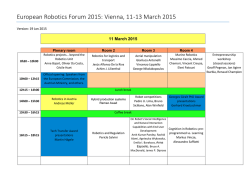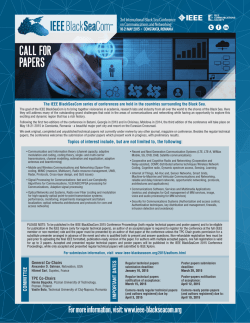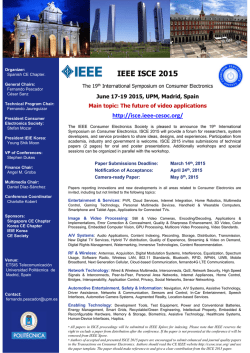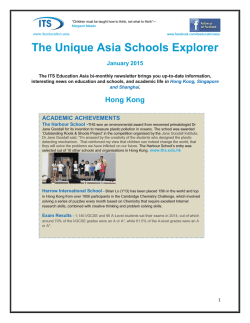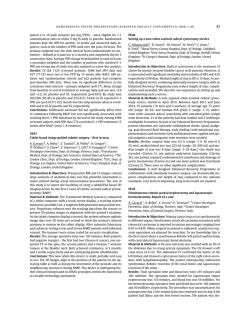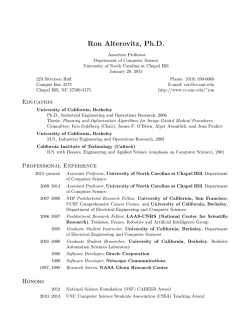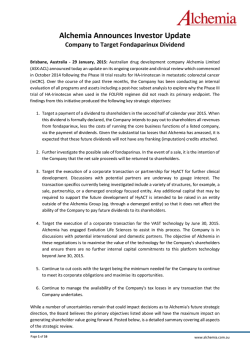
SRG 2015 Workshop - National University of Singapore
REGISTRATIOM FORM Robotic Workshop on Robotics in Rehabilitation COMPANY DATA COMPANY: ADDRESS: ONE DAY ROBOTIC WORKSHOP ON Robotics in Rehabilitation POSTAL CODE: TEL: FAX: CONTACT PERSON: PARTICIPANTS FOR THE WORKSHOP By Professor Sunil K. Agrawal Departments of Mechanical Engineering and of Rehabilitation and Regenerative Medicine Columbia University, New York, USA E-mail: 1. NAME: Mr. / Mrs. / Dr.* DESIGNATION: E-mail: 2. NAME: Mr. / Mrs. / Dr.* Friday, 30 January 2015 9.00 AM TO 5.00 PM Venue: Marie I, Upper Lobby Level York Hotel Singapore 21 Mount Elizabeth, Singapore 228516 The Robotic Workshop is held in cooperation with DESIGNATION: E-mail: 3. NAME: Mr. / Mrs. / Dr.* DESIGNATION: E-mail: * Cancel where applicable Number of Car Park Pass(es) required : ____ IEEE Robotics and Automation Society Singapore Chapter Diet restrictions – International “Halal” Food _____ , Vegetarian _____ and is jointly organised by Robotic Games Society (Singapore), Institute of Technical Education, Nanyang Polytechnic, Nanyang Technological University, National University of Singapore, Ngee Ann Polytechnic, Republic Polytechnic, Singapore Polytechnic, Singapore Science Centre & Temasek Polytechnic. Fee enclosed: S$ . Cheque should be crossed and made payable to Robotic Games Society (Singapore). Completed forms and cheques should be sent to: Mr. Yee Choon Seng SIMTech (Tower Block) 71 Nanyang Drive, Singapore 638075 Tel: 6793-8390 Fax: 6793-8383 E-mail: [email protected] Robotic Workshop on Robotics in Rehabilitation Robotic Exoskeletons for Functional Training of the Motor Impaired This talk will describe two lower extremity exoskeletons with their clinical evaluation for neuro-motor training. ALEX is an Actively driven Leg Exoskeleton which can modulate the foot trajectory using motors at the joints. This exoskeleton was tested on 36 healthy subjects with basic neuroscience question if short-term changes in healthy gait is possible by training[1]. The exoskeleton was also pilot tested on chronic stroke survivors over six-weeks[2]. GBO is a Gravity Balancing un-motorized Orthosis which can alter gravity at the hip and knee joints during swing phase of the gait[3]. This exoskeleton was pilot tested on a chronic stroke survivor, when gravity assistance was decreased over time[4]. This research is supported by grants from the National Institute of Health in USA. [1] S. H. Kim, S. K. Banala, S. K. Agrawal, V. Krishnamoorthy, & J. P. Scholz, “Robot-assisted Modification of Gait in Healthy Individuals”, Experimental Brain Research, Vol. 202, 2010, 809-824. [2]. S. K. Banala, S. H. Kim, S. K. Agrawal, J. P. Scholz, “Robot Assisted Gait Training with Active Leg Exoskeleton (ALEX)”, IEEE Transactions on Neural Systems and Rehabilitation Engineering, Vol. 17, No. 1, 2009, 2-8. [3] S. Banala, S. K. Agrawal, A. Fattah, V. Krishnamoorthy, W. L. Hsu, J. P. Scholz, K. Rudolph, “Gravity Balancing Leg Orthosis and its Performance Evaluation”, IEEE Trans. on Robotics, Vol. 22, No. 6, 2006, 1228-1237. [4] V. Krishnamoorthy, W-L Hsu, W-L, T.M. Kesar, D. L. Benoit, S. K. Banala, S.K., R. Perumal, V. Sangwan, S. A. Binder-Macleod, S. K. Agrawal, & J. P. Scholz, ”Gait Training following stroke: A pilot study combining a gravitybalanced orthosis device, functional electrical stimulation and visual feedback”, Journal of Neurologic Physical Therapy, Vol. 232, December 2008, 192-2. Pediatric Mobile Robots for Functional Learning of Impaired Children Mobility impaired children are limited in exploring their environment. This impacts their cognitive and social developments in important early years. This talk describes a series of studies on mobility training of infants and toddlers using novel prototypes of mobile robots with conventional joystick [1,6], force-feedback joysticks [2,3], mobility interfaces for crawling and walking [4]. These robots were used to teach children “purposeful driving”, “motion primitives such as turning left and right”, “navigation within an obstacles course”, “exercising their arms and legs”. Studies have been performed with these devices in research laboratory, preschool classrooms, and homes [1-6]. The talk will summarize the design of the devices, algorithms, and results of these training studies. This research is supported by grants from National Science Foundation and National Institute of Health. [1] J. C. Galloway, J.C. Ryu, S. K. Agrawal, “Babies driving robots: Self-generated mobility in very young infants”, Intelligent Service Robotics, Vol. 1, No. 2, 2008, pp. 123-134 . [2] Chen, X., Ragonesi, C., Galloway, J.C., and Agrawal, S.K., “Training Toddlers Seated on Mobile Robots to Drive Indoors among Obstacles”, IEEE Trans on Neural Systems & Rehabilitation Engrg, Vol. 19, No. 3, 2011, 271-279. [3] Agrawal, S.K., Chen, X., Ragonesi, C., & Galloway, J.C., “A Novel Haptic Guidance for Learning Steering with Application to Special Needs Children”, IEEE Trans on Haptics, 2012. [4] Chen, X., Liang, S., Dolph, S., Ragonesi, C., Galloway, J.C., Agrawal, S.K., “Design of a Novel Mobility Interface for Infants on a Mobile Robot”, ASME Journal of Medical Devices, Vol. 4, 2010. [5] Ragonesi, C., Chen, X., Agrawal, S., Galloway, J.C., “Power Mobility and Socialization in Preschool: A Case Report on a Child with Cerebral Palsy”, Pediatric Physical Therapy, 2010, 322-329. [6] Agrawal, S.K., Chen, X., Kim, M.J., Lee, Y.M., Cho, H.P., Park, G.J., “Feasibility Study of Robot Enhanced Mobility in Children with Cerebral Palsy”, IEEE BioRob, 2012. Cable-driven Exoskeletons for Training of Movements of the Upper and Lower Body Rehabilitation robots are currently being explored for training of neural impaired subjects or for assistance of those with weak limbs. A current limitation of exoskeletons for rehabilitation is that they require accurate alignment between exoskeletal and human joints. Precise alignment of exoskeletal joint axes with arm joint axes is nearly impossible due to the geometry of bony segments that form the joints and variability among subjects. Conventional arm exoskeletons for rehabilitation are also bulky and heavy. In recent years, we have proposed to make lightweight exoskeletons for rehabilitation by replacing the rigid links of the exoskeleton with lightweight cuffs fixed to the moving limb segments of the human arm [1]. Cables are routed through these cuffs, which are driven by motors, to move the limb segments relative to each other. The merits of the cable-based exoskeleton design are: A cable design is nearly an order of magnitude lighter than current arm exoskeletons; It does not have traditional links and joints, hence, does not require adjustment of link lengths and alignment of joint axes within the exoskeleton; It does not restrict the natural DOFs of the human arm; The architecture of the design is novel as the cables are routed from proximal to distal segments of the arm. However, a scientific limitation of a cable-driven system is that each cable can only pull but not push [3]. We demonstrate via experiments with a cable driven arm exoskeleton (CAREX) that it is possible to achieve desired forces on the hand, i.e., both pull and push, in any direction as required in neural training. The exoskeleton CAREX is currently being tested on humans, both healthy and survivors of stroke, from the perspective of movement training [2]. [1] Mao, Y. and Agrawal, S.K., “A Cable Driven Arm Exoskeleton (CAREX) for Neural Rehabilitation”, IEEE Transactions on Robotics, 2012. [2] Mao, Y. and Agrawal, S.K., “Cable Driven ARm EXoskeleton (CAREX): Transition from experiments on a Mechanical Arm to the Human Arm”, IEEE Intl. Conference on Robotics and Automation, 2012. [3] Mustafa, S.K. and Agrawal S.K., “On the Force-Closure Analysis of n-DOF Cable-Driven Open Chains Based on Reciprocal Screw Theory”, IEEE Trans on Robotics, Vol. 28, No. 1, 2012, 22-31. About the Speaker Sunil K. Agrawal received a Ph.D. degree in Mechanical Engineering from Stanford University in 1990. He is currently the Director of Robotics And Rehabilitation (ROAR) Laboratory at Columbia University. He has published close to 350 journal and conference papers. Dr. Agrawal is a Fellow of the ASME and his honors include a NSF Presidential Faculty Fellowship from the White House in 1994, a Bessel Prize from Germany in 2003, a Humboldt US th Senior Scientist Award in 2007, a Best Paper award at the 35 ASME Robotics and Mechanisms Conference in 2011, and a Best Student Paper Award at the IEEE International Conference in Robotics and Automation in 2012. In the last 5 years, he also held the position of a Distinguished Visiting Professor at Hanyang University in Korea, invited by World Class University program. Currently, he also holds the position of a “Professor of Robotics” at the University of Ulster in Northern Ireland. He has served on editorial boards of several journals published by ASME and IEEE. * ~ * ~ * ~ * ~ * ~ * ~ * ~ * ~ * ~ * ~ * ~ * ~ * ~ * ~ * ~ * ~ * ~ *~ * ~ * ~ * ~ * ~ *~ * ~ * ~ * Details of Robotic Workshop Date : Friday, 30 January 2015 10% discount for early registration with th Time : 9.00 am to 5.00 pm payment before 15 Jan 2015. Fee : S$350 per participant. Full Time Students: S$70. Please attach a copy of student matriculation card with registration. Venue : Marie I, Upper Lobby Level York Hotel Singapore, 21 Mount Elizabeth, Singapore 228516 Who Should attend: Engineers, professional, scientists, and students involved or interested in creative design using new technologies, robotics, and automation. PROGRAMME 9:00 am : 9:15 am : 10:30 am: 11:00 am: 12:30 pm: 2:00 pm: 3:15 pm: 3:45 pm: 5:00 pm: Registration followed by Welcome remarks Robotic Exoskeletons for Functional Training of the Motor Impaired Break Pediatric Mobile Robots for Functional Learning of Impaired Children Lunch Cable-driven Exoskeletons for Training of Movements of the Upper & Lower Body Break Open Discussion End
© Copyright 2026
